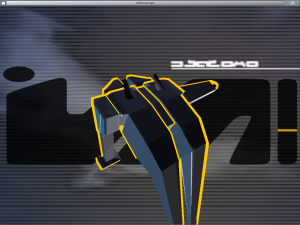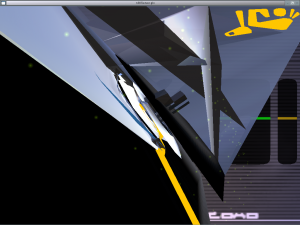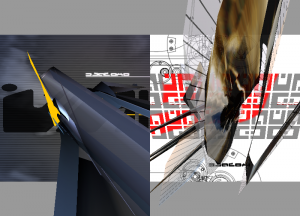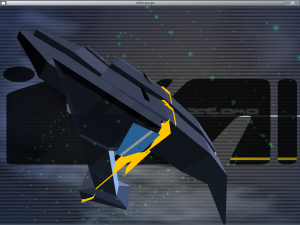The following article about the influence of game engines on contemporary, experimental cinema can be summarised in two points: 1.Although frequently typecast as a jungle of flickering light sabres, the ecology of possible moving image actually covers a much vaster, mostly unexplored terrain.
2. Game-buffs tend to be corruptible, ultra-violent gang-members, and they are busily hacking away at this terrain.
Why You Should Be Afraid
 Beyond the multiplex galaxies, moving images roam freely in a wild variety of configurations – from backyard projections to live-edited, multi-screen, immersive environments; audience triggered, site-based installations; net-native video remixes; and the motion blur of pixels on handhelds. Handhelds in particular however, allow game-buffs to gather as gangs at night, despite the brutal link between on and off screen violence, and taunt wayward cinema goers with lines like ‘Our empire is bigger than Hollywood’. Trouble is, while the oft-repeated fallacy about games outselling movies doesn’t consider the full economic reach of cinema (ticket sales, DVDs, TV sales, etc), game culture has undeniably infiltrated the very production and distribution of the moving image.
In other words, some of the more adventurous hacking of new cinematic terrain just happens to be by game-engine-fuelled auteurs who are uniquely interrogating just what, where and how the moving image might be. Appalled cinema scholars at this point may choose to change pages (it was all a dream), rewind the tape – or insert another coin.
Beyond the multiplex galaxies, moving images roam freely in a wild variety of configurations – from backyard projections to live-edited, multi-screen, immersive environments; audience triggered, site-based installations; net-native video remixes; and the motion blur of pixels on handhelds. Handhelds in particular however, allow game-buffs to gather as gangs at night, despite the brutal link between on and off screen violence, and taunt wayward cinema goers with lines like ‘Our empire is bigger than Hollywood’. Trouble is, while the oft-repeated fallacy about games outselling movies doesn’t consider the full economic reach of cinema (ticket sales, DVDs, TV sales, etc), game culture has undeniably infiltrated the very production and distribution of the moving image.
In other words, some of the more adventurous hacking of new cinematic terrain just happens to be by game-engine-fuelled auteurs who are uniquely interrogating just what, where and how the moving image might be. Appalled cinema scholars at this point may choose to change pages (it was all a dream), rewind the tape – or insert another coin.
Engine Mechanics
 Fans of music that is glitchy, textural, stutter-core – married with wildly deconstructing 3D graphics, will love the possibilities suggested by the audiovisual tool fijuu. fijuu is an impressive 3D, audiovisual performance engine built by Pix & Julian Oliver, Aussie ex-pats new-media slumming it in Europe. fijuu allows dynamic manipulation of 3D instruments using Playstation2 style gamepads to make improvised music – which, combined with the tightly synchronised motion graphics and spatial explorations, forms a highly compelling and unusual audiovisual experience. And at the bleeping heart of fijuu? – the open source game engine Nebula running on Linux.
Fans of music that is glitchy, textural, stutter-core – married with wildly deconstructing 3D graphics, will love the possibilities suggested by the audiovisual tool fijuu. fijuu is an impressive 3D, audiovisual performance engine built by Pix & Julian Oliver, Aussie ex-pats new-media slumming it in Europe. fijuu allows dynamic manipulation of 3D instruments using Playstation2 style gamepads to make improvised music – which, combined with the tightly synchronised motion graphics and spatial explorations, forms a highly compelling and unusual audiovisual experience. And at the bleeping heart of fijuu? – the open source game engine Nebula running on Linux.
“During performance, you quickly start to think in terms of the sound and the image and not the interface in between,” explains Julian, who also helps maintain the game portal selectparks.net. “Game interfaces are designed to be somewhat transparent, and when you are very involved in a game you don’t think of yourself as moving a stick or pressing a button on a gamepad, but in terms of the game you are playing – running, jumping, etc.” Building a live audiovisual composition and musical tool has brought unusual challenges, but also delivers unusual rewards.
 “There is little in the way of ‘visual meaning’ in fijuu, more hedonistic splashes of happy coincidences that produce sensorial indiscrete experiences. We rely quite heavily on the graphics to motivate improvisation. When attention is focused on one aspect, you will often have your attention snared by an unintentional discovery in the other.”
“There is little in the way of ‘visual meaning’ in fijuu, more hedonistic splashes of happy coincidences that produce sensorial indiscrete experiences. We rely quite heavily on the graphics to motivate improvisation. When attention is focused on one aspect, you will often have your attention snared by an unintentional discovery in the other.”
fijuu will eventually include a non-linear beat pattern sequencer, granular synthesis tools and a graphical filterbank, and be released as a live CD Linux project, meaning players will be able to boot up a PC and play fijuu with a PS2 style gamepad (without installing anything). Until then, a very impressive 50mb movie at http://www.fijuu.com demonstrates some of fijuu’s wild potential.
Virtual Cinema
Machinima is the much touted utilisation of game engines for a slightly less abstract purpose – creating virtual sets to ‘film/record/enact movies within. RMIT Masters student Chris Dodds is a devout machinima enthusiast, launching the MachinimaAU portal in mid 2005 to help nurture the local Machinima industry.
“Compared to traditional filmmaking, equipment is relatively cheap and most people already have access to a fast computer and appropriate games. Moving quality real-time game play from screen to hard-drive for editing is a little problematic” explains Chris, “But next generation in-game capture and edit tools will offer machinima production to a broader community. With this comes volume and the most creative producers will rise to the top.”
Honey, I Augmented The Kids

Images from fijuu system
Yet another use for game engines? ‘Augmented Reality’ is the catchphrase for overlaying game graphics onto the ‘natural’ field of vision of a player / audience member, usually via some sort of visor or VR helmet. While Blast Theory (UK) & PacManhattan (US) are already Augmented Reality luminaries, Adelaide’s A-rage are hoping to join the list with their development of wearable hardware enabling existing game consoles to be plugged in, and overlaid/played on top of the world around. Beyond the commercially appealing first person shooters, Creative Director of A-rage, Joe Velikovsky sees much potential for location based, historically immersive and ‘edgy, artistic’ augmented productions.
“We want to get the hardware out to the marketplace with a 5-game bundle in about 18 months, then we’d like to get other developers porting their stuff to the A-rage peripheral. Maybe then we’ll look at open source. Looking waaaay forward, it’d be great to have a free dev kit so that people could make machinima and play them back inside their A-rage headset. This really opens up possibilities for new forms of narrative for digital media artists – and their audiences.”
Jean Poole
Jean Poole founded Electrofringe back in the twentieth century. Since then he has pursued real-time audiovisual software like a gambler on the verge of cracking some casino code.
Read More
http://www.collapsicon.net/ – Brisbane’s resident Nintendo circuit-bender & game-engine hacker
 This work is licensed under a Creative Commons Attribution-NonCommercial-ShareAlike 3.0 Australia.
This work is licensed under a Creative Commons Attribution-NonCommercial-ShareAlike 3.0 Australia.







